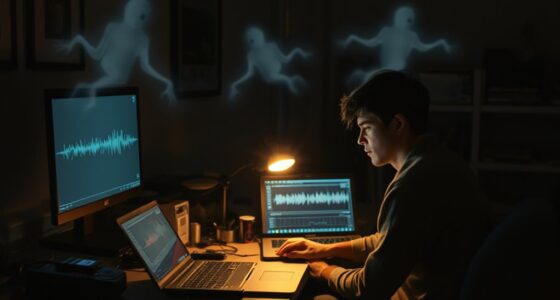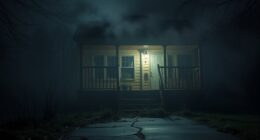To create audience maps of paranormal hotspots, start by collecting detailed reports from eyewitness accounts, online forums, and social media to identify patterns and clusters. Use mapping tools like Google My Maps or ArcGIS to visualize these hotspots with heatmaps and interactive features. Analyzing the data helps you spot trends and activity concentrations. Following ethical practices guarantees respectful investigations. Keep exploring to discover more strategies for accurate, responsible mapping of paranormal activity.
Key Takeaways
- Gather firsthand reports from online forums, social media, and community groups to identify locations with frequent paranormal activity.
- Use mapping software like ArcGIS, Google My Maps, or QGIS to visualize data points and create interactive hotspot maps.
- Analyze spatial patterns and clusters with heatmaps and clustering algorithms to pinpoint significant paranormal hotspots.
- Incorporate temporal data to observe activity shifts over time, enhancing the accuracy of audience maps.
- Share visualizations with the community, highlighting key areas and encouraging feedback for ongoing refinement.
Gathering and Analyzing Paranormal Reports

To create accurate audience maps of paranormal hotspots, you first need to gather and analyze reports from a variety of sources. Start by collecting firsthand accounts from witnesses, including detailed descriptions of sightings, sounds, or sensations. Review online forums, ghost hunting websites, and local news articles to uncover patterns and recurring locations. Record dates, times, and conditions under which reports are made to identify potential trends. Cross-reference these reports with official records of unusual activity or historical data to verify consistency. Be objective and look for commonalities rather than outliers. This thorough analysis helps you pinpoint areas with frequent activity, forming a solid foundation to map where paranormal phenomena are most reported and potentially more active. Incorporating vetted sources ensures the credibility of your data and enhances the accuracy of your audience maps.
Utilizing Social Media and Community Input
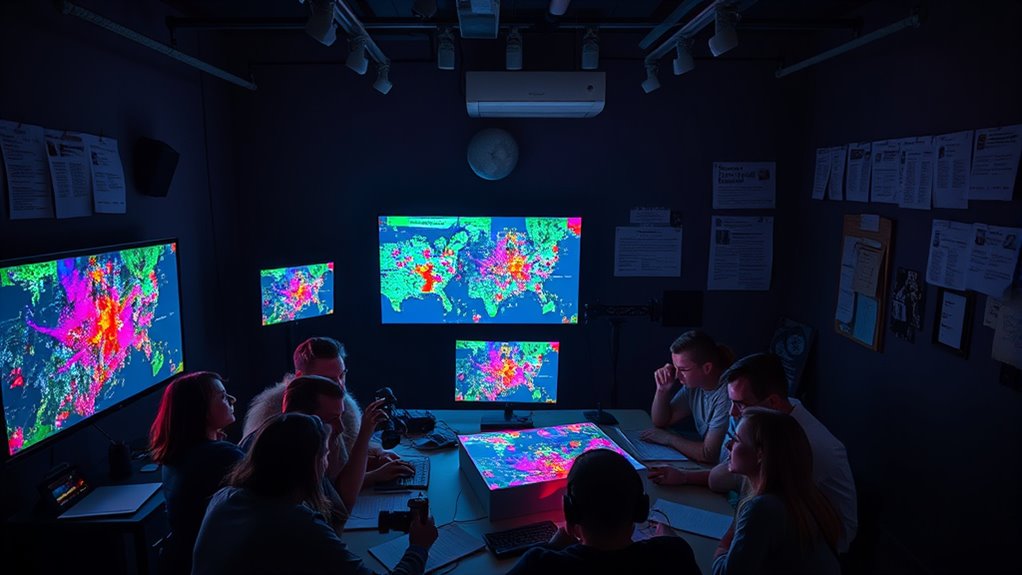
Leveraging social media and community input can substantially enhance your understanding of paranormal hotspots. By engaging with online groups, forums, and local communities, you gather firsthand accounts and identify trending locations. Encourage community members to share their experiences, photos, and videos, which provide valuable insights. Use social media platforms to monitor keywords and hashtags related to paranormal activity, helping you spot patterns and hotspots quickly. To organize your findings, consider this approach:
| Source | Type of Input | Benefits |
|---|---|---|
| Social Media | User posts, hashtags | Real-time updates |
| Community Forums | Personal stories | Detailed, diverse accounts |
| Local Groups | Events, reports | Verified, localized info |
This multi-channel approach ensures a comprehensive map of paranormal activity.
Mapping Tools and Software for Visualizing Data
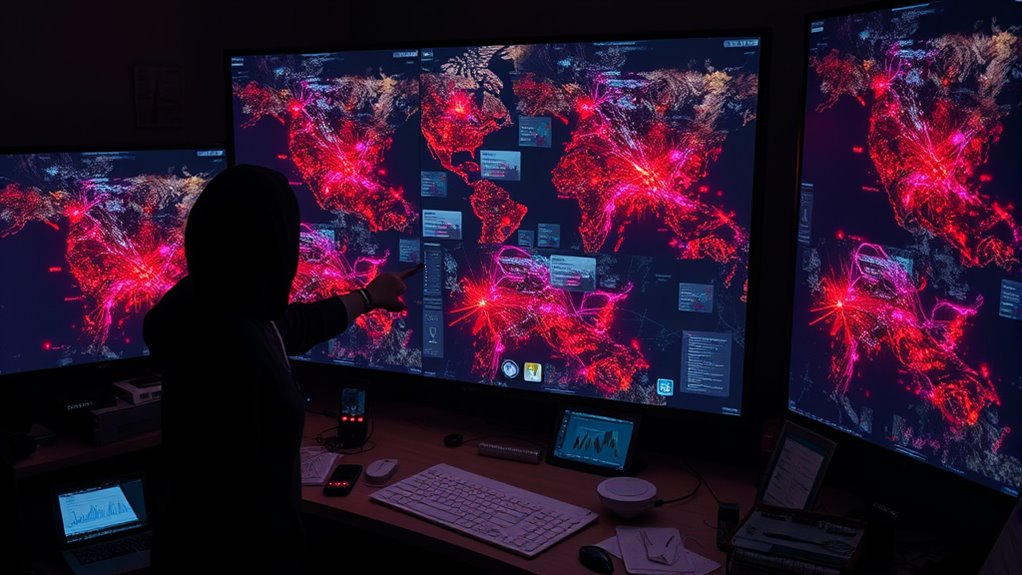
You have several mapping software options to choose from, each with unique features suited for visualizing paranormal hotspots. By understanding different data visualization techniques, you can create clearer, more compelling audience maps. Selecting the right tools helps turn raw data into insightful visual stories your audience will find engaging.
Mapping Software Options
Choosing the right mapping software is essential for accurately visualizing paranormal hotspots. You want tools that are user-friendly, flexible, and capable of handling multiple data layers. Options like ArcGIS Online offer advanced features for spatial analysis, but may require a steep learning curve. Google My Maps provides an intuitive platform ideal for beginners, allowing you to create custom maps quickly. QGIS is a powerful open-source software that supports complex data manipulation, perfect if you need detailed control. Mapbox combines ease of use with customization options for interactive maps. Consider your technical skills, budget, and project scope when selecting software. The right choice will streamline your mapping process and lead to clearer, more compelling visualizations of paranormal hotspots. Additionally, understanding mapping software features can help you choose the best tools suited to your specific needs.
Data Visualization Techniques
Effective data visualization transforms raw paranormal data into clear, compelling maps that reveal hotspots and patterns. To do this, you need the right tools and techniques. Use mapping software like ArcGIS or QGIS to layer your data points, add heatmaps, and highlight areas of interest. Color-coding helps differentiate intensity levels, while clustering shows concentrations of activity. Incorporate interactive features—zoom, filter, and tooltips—to explore data dynamically. Employ chart overlays or side panels for contextual insights. Make certain your visualizations are intuitive, focusing on clarity and accuracy. You want your audience to quickly grasp where paranormal activity concentrates and identify trends. By mastering these visualization techniques, you can create engaging maps that effectively communicate your findings and captivate your viewers. Retail hours today list can inform scheduling considerations for site visits or data collection.
Identifying Patterns and Clusters of Activity
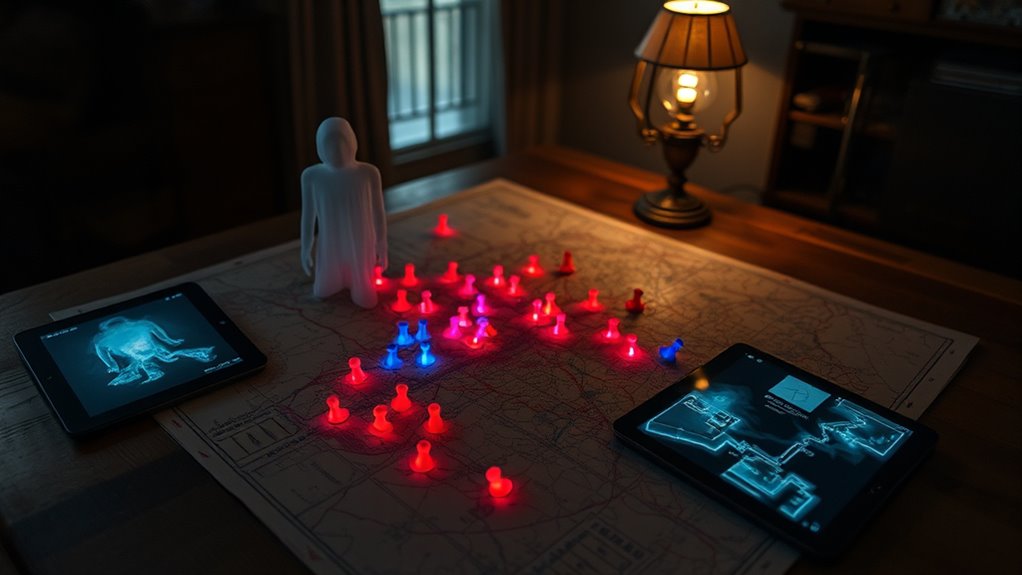
You can start by mapping activity hotspots to see where paranormal reports occur most frequently. Look for pattern clusters that suggest specific areas or times of heightened activity. Analyzing temporal trends helps you understand if patterns change over time or during certain conditions. Incorporating top-rated locations based on recent reports can also improve the accuracy of your audience maps.
Mapping Activity Hotspots
Have you ever wondered how paranormal investigators identify the most active sites? They use mapping tools to plot reports, sightings, and recorded phenomena. By entering data into digital maps or GIS software, you can visualize where activity concentrates. Look for areas with multiple reports over time and note recurring patterns. These hotspots often reveal underlying factors, like architectural features or environmental conditions. You can also overlay historical data, such as old legends or previous investigations, to see if patterns align. Recognizing these clusters helps you focus your efforts on the most promising locations. Mapping activity hotspots isn’t just about pinpointing locations; it’s about understanding the spatial relationships and frequency of activity, which guides subsequent investigations and resource allocation. Incorporating size restrictions and local regulations into your planning can ensure your investigation sites are compliant and accessible.
Detecting Pattern Clusters
Once you’ve mapped out activity hotspots, the next step is to detect patterns and clusters within that data. Look for areas where activity concentrates or repeats over multiple observations. Use spatial analysis tools, like heat maps or clustering algorithms such as DBSCAN, to identify significant groupings. These clusters reveal where activity is most intense and consistent, helping you focus your investigations. Pay attention to the density and proximity of activity points; tightly packed points often indicate genuine hotspots. Also, consider the size and shape of clusters to distinguish between random noise and meaningful patterns. Recognizing these patterns allows you to prioritize locations and understand how activity may be connected across different areas. This step brings clarity to your hotspot data, guiding your next moves effectively. Incorporating privacy considerations ensures your analysis respects ethical standards and user data security.
Analyzing Temporal Trends
To effectively analyze temporal trends, focus on how paranormal activity varies over different time periods. Look for patterns such as spikes during specific hours, days, or seasons. Use time-series analysis tools to visualize activity fluctuations and identify recurring peaks. Consider external factors like weather, holidays, or local events that might influence activity levels. Break down your data into smaller intervals—hourly, daily, weekly—to reveal hidden patterns. Detecting consistent clusters during particular times can help you pinpoint when hotspots are most active. This approach enables you to understand not just where, but when paranormal phenomena are most prevalent, providing deeper insights into the nature of these activities and helping you refine your audience maps for better accuracy. Additionally, examining vetted sources can enhance your understanding of patterns observed in paranormal hotspots.
Sharing and Interpreting Audience Maps
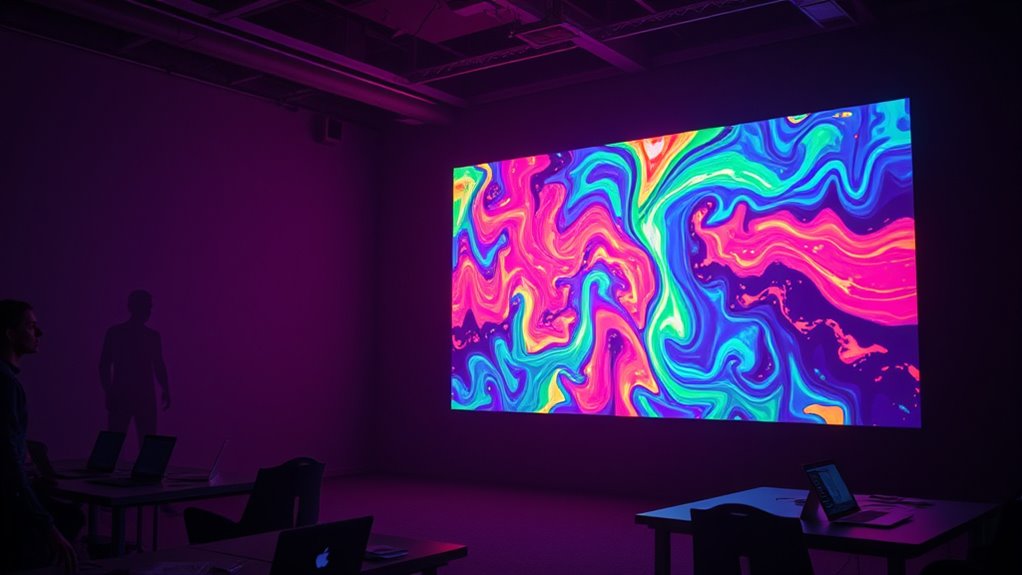
Sharing and interpreting audience maps allows you to transform raw data into meaningful insights about paranormal hotspots. When you share these maps, you help others see patterns and trends that might not be obvious at first glance. Use clear visuals and annotations to highlight key areas of interest, making it easier for your audience to understand where activity is concentrated. As you interpret the maps, look for clusters, overlaps, and shifts over time that reveal potential hotspots or changing behaviors. Encourage questions and discussions to deepen understanding. Remember, your goal is to make the data accessible and engaging, helping others see the significance of the findings. Effective sharing turns complex data into actionable insights, fostering a community of informed enthusiasts and investigators.
Ethical Considerations and Responsible Exploration
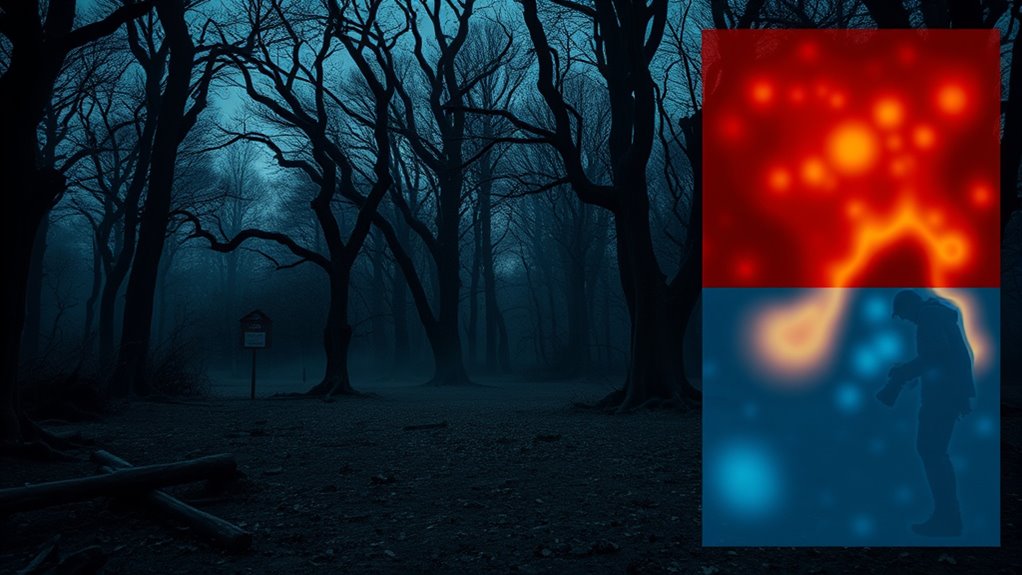
As you explore paranormal hotspots, it’s crucial to prioritize ethical considerations to respect both the locations and the communities involved. You should always seek permission before investigating, ensuring you’re not trespassing or causing disruption. Be transparent about your intentions, avoiding sensationalism that could misrepresent the site or offend locals. Respect the history and cultural significance of each location, refraining from vandalism or invasive recordings. Remember, your actions can impact the community’s perception of the site and its preservation. To stay responsible, consider these key points:
- Obtain necessary permissions and permits
- Respect local customs and sensitivities
- Minimize environmental and emotional disturbance
- Be aware of the signs of spoilage that could affect your equipment or health during investigations.
Frequently Asked Questions
How Can I Verify the Accuracy of Paranormal Reports?
To verify paranormal reports, you should gather multiple accounts from different sources to identify patterns. Interview witnesses carefully, asking detailed questions to clarify their experiences. Cross-check reports with historical records or physical evidence, like photos or audio recordings. Use scientific methods, such as environmental measurements or sensor data, to support or refute claims. Remember, skepticism and thorough investigation are key to distinguishing genuine phenomena from hoaxes or misinterpretations.
What Legal Issues Arise When Mapping Paranormal Hotspots?
You need to take into account privacy laws and property rights when mapping paranormal hotspots. Avoid sharing specific locations that could lead to trespassing or invasion of privacy. Obtain permission from property owners before including their sites, and ensure your data collection complies with local regulations. Be cautious about how you publish your maps to prevent legal disputes, and always respect individuals’ privacy and property rights to stay within the law.
How Do Cultural Differences Influence Audience Map Interpretations?
Cultural differences shape how you interpret audience maps like a prism distorts light, revealing varied colors. You might see certain hotspots as sacred or spooky, depending on local beliefs and history. These perceptions influence your understanding of the data, making some regions seem more significant than others. By respecting diverse cultural lenses, you guarantee your map accurately reflects local attitudes, preventing misinterpretations that could lead to misunderstandings or offense.
Can Audience Maps Predict Future Paranormal Activity?
Audience maps can’t predict future paranormal activity with certainty. They show where interest or reports are concentrated but don’t have the power to forecast occurrences. Your interpretation depends on patterns and historical data, but the unpredictable nature of the paranormal makes precise predictions impossible. Instead, focus on analyzing current hotspots to understand potential trends, while remaining aware that actual future activity could differ due to numerous unpredictable factors.
What Safety Precautions Should Explorers Take When Visiting Hotspots?
When visiting hotspots, always prioritize safety by bringing a trusted companion, wearing appropriate protective gear, and informing someone about your plans. Carry a flashlight, first-aid kit, and fully charged phone. Stay aware of your surroundings, avoid dangerous structures, and trust your instincts. Respect the environment, avoid provoking spirits, and know your limits. These precautions help guarantee your exploration remains safe and enjoyable while uncovering paranormal mysteries.
Conclusion
By creating audience maps of paranormal hotspots, you gain a clearer picture of where activity concentrates. While some believe these patterns reveal genuine supernatural hotspots, others argue they’re influenced by local legends or social media trends. Whatever the case, using data responsibly can help you explore these mysteries thoughtfully. Remember, whether or not these spots hold real paranormal energy, your curiosity and careful analysis bring new insights to the age-old question: is there more beyond our understanding?




